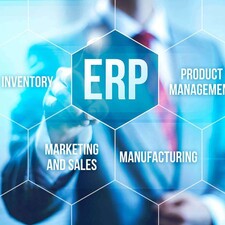Blog
Production Planning: Mapping Out Your Operations

Summary
Production planning helps business owners, entrepreneurs and manufacturers gain full control of their companies by providing detailed steps and guidelines regarding the entire operational process from start to finish.
When operating any type of company, there is more involved than just hiring the workers and leasing or purchasing equipment. Simply placing all these aspects on the shop floor doesn't ensure that the product will be built to the highest quality at specified deadlines. There are numerous key details and processes that need to be hammered out, such as materials acquisition, quality control inspections, product demand forecasting, supply chain development and other factors.
What is Production Planning?
Think of production planning as a roadmap or flowchart of how you plan to manage and control every resource in your operations. It is designed to help you allocate the right resources toward processes at the right times. This plan should also help you evaluate and mitigate risks, and create efficient operations throughout the lifecycle of the company.
The production plan also allows you to set a benchmark to your operations. You are able to build the foundation on which you want the company to grow, as you can use it to track output, locate current and future inefficiencies, and immediately adjust operations when there are any sudden changes to processes.

Benefits to Production Planning
When an effective production plan is made, it should cover various aspects of the production process such as demand forecasting, inventory control, equipment resources, employee availability, standardized production steps, product delivery and risk factors. Once each aspect is mapped out, you may see these benefits.
- Greater Inventory Control: You will only order the raw materials that will be needed for production processes, reducing waste and excess. In addition, you will know the amount of work-in-progress (WIP) and finished products that will be needed to fill orders to handle increases and decreases in demand.
- Improved Process Flow: You'll have a deeper understanding of what equipment and workers will be needed for every process. You'll be able to eliminate waste by optimizing equipment usage, and lower labor costs when necessary.
- Streamline Supply Chains: You'll have greater insight on when raw materials are delivered and when finished products are shipped out. You'll be able to improve customer satisfaction and develop strong vendor relations.
- Interdepartmental Collaboration: Effective production planning will help to bring each department onto the same page about knowing what their role is in operations, and what will need to be done to meet the company's objectives.
Steps to Production Planning
The number of steps to production planning will be based on your specific operations. Not every company will have the same supply chain processes or production risks. The basic steps to production planning involves: routing, scheduling, dispatching, and monitoring & control. Before the production planning can take place, you'll need to sit down and determine the market demand expectations.
Market demand forecasting is essential to the entire production plan. Once you figure out the demand forecast, you'll know what products will need to be made during different sales times, how many products will need to be produced, and the amount of raw materials that are needed to make the required products. You'll be able to successfully source materials from vendors when required.
Once market demand forecasting is done, then you can focus on the details of the production plan.
Step 1: Product Routing
Product routing simply lets you figure out how the product creation will flow through the entire production operations. It maps the route that raw materials will take once they reach the company and how they will move through the operations until becoming the final end product, or WIP if it is shipped out to the final processor.
With product routing, you'll be able to perform material requirements planning (MRP) to figure out what resources (labor and equipment) will be needed. You'll also be able to create a bill of materials (BOM) that will detail what materials will be used to make the product when a sales order comes in. With the product routing mapped out, you'll also know where all the equipment and labor should be placed in the facility for a streamlined, efficient work environment.
Step 2: Scheduling of Processes
The second step to the production planning involves understanding the time it will take for each operation to complete its function in the production process. It should also focus on possible downtimes or deviations that may occur to the schedule. By scheduling the processes, you'll know how long it takes for raw materials to be transformed into finished products to complete orders. You'll also know the amount of time that you will have to give to vendors to receive the raw materials, and are able to tell customers when on-time delivery will be made.
There are several different types of schedules that will be created: a master schedule, an operation schedule and a daily schedule -- to name a few. With these schedules, you'll be able to locate inefficiencies and the reasons why those issues have appeared so you can take the appropriate remediation.
Step 3: Dispatching of Orders
One of the major problems that can appear with high volume production runs is not having the available materials to successfully complete the entire order. Yet you don't want to discover this issue as products are being made only to have equipment processes shut down midway and workers unable to perform their job roles.
The dispatching of orders basically focuses on what key factors will allow initiation of a certain process to move forward. It focuses on verifying orders and drawings, determining issues with materials, and moving work from one process to the next. By figuring out how orders are dispatched, it will allow you to switch between different production runs if certain materials are running low or there are issues with specific equipment or labor resources.
Step 4: Monitoring & Control
The monitoring & control part of production planning will state what equipment and steps that will be taken to ensure all progress is made with your production line and that product quality meets expectations. It provides risk management evaluation and mitigation, as well as the controls that are put into place to implement.
It should also provide details of the job roles that employees will have when issues are found so everyone will know what to do to get the production plan back on track.
Modify Production Plans When Required
Production plans are not set in stone. Operations can change based on downsizing operations or when expanding processes. The production planning phase should always be revisited and adjusted so that it reflects current operations and company objectives.
Looking for new a ERP system? Download the guide: Selecting an ERP System in 7 Easy Steps


